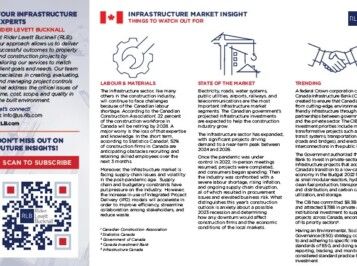Offering clients the level of certainty they need to make critical, real-time decisions to ensure the commercial success of their infrastructure projects.
Our Canadian infrastructure market insights document lets industry leaders and clients know what factors to keep an eye on, whether that be labour & materials, the state of the market, or trends. We also keep you informed on relevant construction cost drivers and how this information impacts the future of the sector.
We have also created a U.S. Infrastructure Market Insight document, which can be found here.
Things to watch out for
Labour & Materials
The infrastructure sector, like many others in the construction industry, will continue to face challenges because of the Canadian labour shortage. According to the Canadian Construction Association, 22 percent of the construction workforce in Canada will be retiring by 2028. A major worry is the loss of that expertise and knowledge. In the short term, according to Statistics Canada, 52% of construction firms in Canada are anticipating obstacles recruiting and retaining skilled employees over the next 3 months.
Moreover, the infrastructure market is facing supply chain issues and volatility in the post-pandemic age. Supply chain and budgetary constraints have put pressure on the industry. However, the increase in use of Integrated Project Delivery (IPD) models will accelerate in order to improve efficiency, streamline collaboration among stakeholders, and reduce waste.
State of the Market
Electricity, roads, water systems, public utilities, airports, railways, and telecommunications are the most important infrastructure market segments. The Canadian government’s projected infrastructure investments are expected to help the construction industry grow.
The infrastructure sector has expanded, with significant projects driving demand to a near-term peak between 2024 and 2026.
Once the pandemic was under control in 2022, in-person meetings resumed, projects were completed, and consumers began spending. Then the industry was confronted with a severe labour shortage, rising inflation, and ongoing supply chain disruption, all of which resulted in procurement issues and elevated business risk. What distinguishes this year’s construction outlook is anxiety about a possible 2023 recession and determining how any downturn would affect construction firms and the economic conditions of the local markets.
Trends
This chart represents the funding update for the Infrastructure Canada Department.
What this chart means for you
Through the Investing in Canada Plan, the Government of Canada is investing over $180B over 12 years in infrastructure projects across Canada. These investments are being made by 21 federal departments and agencies. Building on the first phase of the Plan, $81.2B in additional funding was made available in the federal Budget to support five priority areas over the next decade: public transit, green, social, trade and transportation, and rural and northern communities’ infrastructure and provides predictable funding and focus on large-scale transformational projects.
Those programs and projects are identified in the chart above to demonstrate the focus areas with reserved spending allocations. The clear heaviest spending has been allocated to the federal Canada Community-Building Fund which supports approximately 4,000 infrastructure projects in 3,600 communities across the country each year.
FURTHER INFORMATION:

Peter Vavaroutsos



